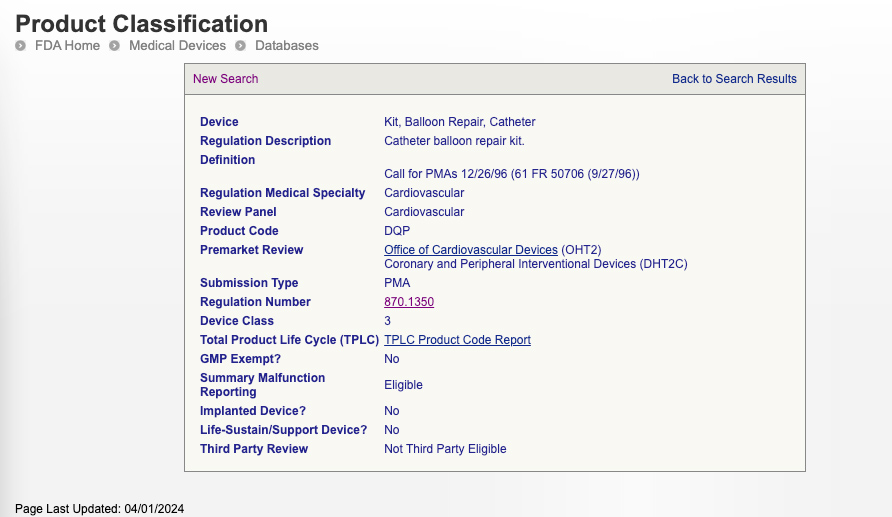All Class III medical devices are subject to premarket approval as part of their regulatory controls. If your device is Class III, you’ll be required to submit a PMA application and must receive FDA approval of said application before marketing your device in the United States.
Additionally, even after a Class III medical device has been approved by the FDA, the agency will still require post-approval activities, which may include post-approval studies to ensure the long-term safety and effectiveness of the device.
Class III medical devices (high risk) are subject to general controls and premarket approval.
Such a system helps you stay compliant throughout the life cycle of your Class III medical device
You will be able to determine the classification of most medical devices by finding the matching description of the device in 21 CFR Parts 862–892. Within these parts, the FDA has described and organized more than 1,700 distinct types of devices and organized them by medical specialty. For example, Part 872 covers dental devices.
You can find the full requirements for the premarket approval process in 21 CFR Part 814; for a more streamlined version, check out this guide to the PMA submission process.
As you can see, all devices are subject to general controls, although Class III devices are the only class subject to the premarket approval (PMA) process. This is because the FDA deems that general and special controls alone aren’t enough to ensure their safety and effectiveness.
One of the largest sections in your PMA application will be devoted to clinical and nonclinical investigations of your device. Irregularities in your clinical trials are grounds for denial of approval by the FDA.
Published April 8, 2024, on the Greenlight Guru blog.
منبع: https://www.qualitydigest.com/inside/customer-care-article/what-class-iii-medical-device-us-042524.html
Class II medical devices (moderate to high risk) are subject to both general controls and special controls.

Although devices are classified based on the risk they pose and the regulatory controls necessary to ensure safety and effectiveness, classification is also dependent on both the device’s intended use and its indications for use.
Given the significant risk inherent in Class III devices, and the often critical nature of their role in medicine, Class III devices are subject to the most stringent regulatory controls. Here, I’ll cover device classification, regulatory pathways, and more for Class III medical devices.
How does FDA categorize Class III medical devices?
The classic example is a scalpel, which has an intended use of cutting tissue and is generally a Class I device. However, if a manufacturer were to choose a more specialized indication for use—such as making an incision in the cornea—the risk associated with the device would increase. In that case, it would become a Class III medical device.
What are some examples of Class III medical devices?
Class I medical devices (low to moderate risk) are subject to general controls.
Class III medical devices exist in a wide range of medical specialties, and it’s not always obvious that a device is deemed to be high-risk. For example, here are several examples of Class III medical devices:
• Pacemakers
• Defibrillators
• Implanted prosthetics
• Cochlear implants
• Breast implants
• Intraocular lenses
• Renal stents
• Software as a medical device (SaMD) that meets the FDA’s criteria for a Class III device
How do you determine whether you have a Class III medical device?
The PMA process is lengthy and requires extensive scientific review of your device and the clinical evidence regarding its safety and effectiveness. It’s important here to remember that Class III medical devices require some level of clinical investigation to obtain the appropriate clinical data about their safety and effectiveness.
That’s why it’s a good idea to use a modern, compliant electronic data collection (EDC) system such as Greenlight Guru Clinical for your clinical data collection. This comprehensive EDC solution helps you stay compliant from Day One and ensures traceability and security for your clinical data.
For the most part, you should be able to determine your device’s risk class using these methods. But if you would like a formal determination of device class from the FDA, you can submit a 513(g) request.
What is the premarket approval process for Class III medical devices?
The FDA classifies medical devices by risk into three categories: Class I, Class II, and Class III, with Class III medical devices as the highest risk class.
The FDA defines a Class III medical device as “one that supports or sustains human life or is of substantial importance in preventing impairment of human health or presents a potential, unreasonable risk of illness or injury.”
The FDA assigns a device to a risk class based on the level of regulatory controls required to ensure that the device is safe and effective.
You can also search the FDA’s classification database using part of the device’s name. Once you find the product that corresponds with your device, you will also be able to see its risk class. For example, a catheter balloon repair kit is a Class III cardiovascular device. Here is how it appears in the classification database:
In the United States, the Food and Drug Administration (FDA) is the federal agency tasked with regulating the medical device market and ensuring the safety and effectiveness of all devices for patients.
